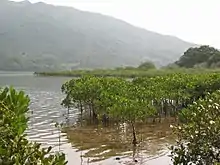Aegiceras corniculatum
Aegiceras corniculatum, commonly known as black mangrove, river mangrove or khalsi, is a species of shrub or tree mangrove in the primrose family, Primulaceae, with a distribution in coastal and estuarine areas ranging from India through South East Asia to southern China, New Guinea and Australia.[3]
| Aegiceras corniculatum | |
|---|---|
 | |
| Scientific classification | |
| Kingdom: | Plantae |
| Clade: | Tracheophytes |
| Clade: | Angiosperms |
| Clade: | Eudicots |
| Clade: | Asterids |
| Order: | Ericales |
| Family: | Primulaceae |
| Genus: | Aegiceras |
| Species: | A. corniculatum |
| Binomial name | |
| Aegiceras corniculatum | |
| Synonyms | |
| |

Description
Aegiceras corniculatum grows as a shrub or small tree up to 7 metres (23 ft) high, though often considerably less. Its leaves are alternate, obovate, 30–100 millimetres (1.2–3.9 in) long and 15–50 millimetres (0.59–1.97 in) wide, entire, leathery and minutely dotted. Its fragrant, small, white flowers are produced as umbellate clusters of 10–30, with a peduncle up to 10 mm long and with pedicels 10–18 millimetres (0.39–0.71 in) long. The calyx is 2–4 millimetres (0.079–0.157 in) long and corolla 4–6 millimetres (0.16–0.24 in) long. The fruit is curved and cylindrical or horn-shaped, light green to pink in colour and 20–75 millimetres (0.79–2.95 in) long.[3] It grows in mud in estuaries and tidal creeks, often at the seaward edge of the mangrove zone.[4]
The species is of interest to many moths, including species from the genera Anarsia, Archips and Phyllocnistis, as well as the species Darna trima, Gonodontis clelia and Neurozerra conferta.[2]
Medicinal uses
Aegiceras corniculatum extract has analgesic properties[5] which supports a fight against diabetes.[6] The stems of the plant contain up to seven compounds, including: 2-methoxy-3-nonylresorcinol, 5-O-ethylembelin, 2-O-acetyl-5-O-methylembelin, 3,7-dihydroxy-2,5-diundecylnaphthoquinone, 2,7-dihydroxy-8-methoxy-3,6-diundecyldibenzofuran-1,4-dione, 2,8-dihydroxy-7-methoxy-3,9-diundecyldibenzofuran-1,4-dione (6), and 10-hydroxy-4-O-methyl-2,11-diundecylgomphilactone.[7]
References
- Ellison, J.; Koedam, N.E.; Wang, Y.; Primavera, J.; Jin Eong, O.; Wan-Hong Yong, J.; Ngoc Nam, V. (2010). "Aegiceras corniculatum". IUCN Red List of Threatened Species. 2010: e.T178797A7608891. doi:10.2305/IUCN.UK.2010-2.RLTS.T178797A7608891.en.
- Aegiceras corniculatum (L.) Blanco Retrieved 2019-04-24.
- "Aegiceras corniculatum". PlantNET - New South Wales Flora Online. Royal Botanic Gardens & Domain Trust. Retrieved 2019-04-24.
- Neha Tusharbhai Patel; Amar Nath Pandey (2009). "Salinity tolerance of Aegiceras corniculatum (L.) Blanco from Gujarat coasts of India" (PDF). Anales de Biología. 31: 93–104.
- Roome, Talat; Dar, Ahsana; Naqvi, Sabira; Choudhary, M. Iqbal (2011). "Evaluation of antinociceptive effect of Aegiceras corniculatum stems extracts and its possible mechanism of action in rodents". Journal of Ethnopharmacology. 135 (2): 351–8. doi:10.1016/j.jep.2011.03.025. PMID 21419211.
- S. Gurudeeban; K. Satyavani; T. Ramanathan; T. Balasubramanian (2012). "Antidiabetic effect of a black mangrove species Aegiceras corniculatum in alloxan-induced diabetic rats". J. Adv. Pharm. Technol. Res. 3 (1): 52–56. doi:10.4103/2231-4040.93560 (inactive 2021-01-11). PMC 3312728. PMID 22470894.CS1 maint: DOI inactive as of January 2021 (link)
- Xu M; Deng Z; Li M; Li J; Fu H; Proksch P; Lin W (2004). "Chemical constituents from the mangrove plant, Aegiceras corniculatum". Journal of Natural Products. 67 (5): 762–6. doi:10.1021/np030477z. PMID 15165134.
External links
- "Aegiceras corniculatum (L.) Blanco". Atlas of Living Australia.
